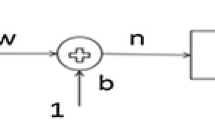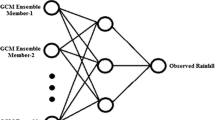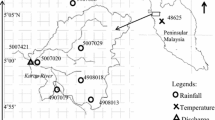Abstract
In this work, an approach based on Artificial Neural Networks (ANN) has been employed to assess the likely impact of climate change on mean monthly maximum and minimum temperature (T max and T min) in the Chaliyar river basin, Kerala, India. ANN is trained to downscale temperature from the General Circulation Model (GCM) from a coarser resolution to the required resolution of the river basin. The work aims to estimate the GCMs’ output to the scales compatible with that employed in a hydrologic model of the river basin. In order to satiate this purpose, predictor variables were obtained from the National Centre for Environmental Prediction and National Centre for Atmospheric Research (NCEP/NCAR) reanalysis data; this was utilized for training the ANN using a feed-forward network with a back-propagation algorithm. These models were validated further and used to downscale CGCM3 GCM simulations for the scenarios outlined in the IPCC Special Report on Emission Scenarios (SRES). Results showed that both T max and T min are increasing consistently in all the scenarios. T max exhibited an average increase of maximum 3 °C during the dry season (December–May) and 1 °C during the wet season (June–November) by the year 2100, while T min showed an average increase of 2.5 °C in the dry season and 0.5 °C in the wet season.







Similar content being viewed by others
References
ACIA (2005) Arctic Climate Impact Assessment. Cambridge University Press, 1042p.
Anandhi A, Srinivas VV, Kumar DN, Nanjundiah RS (2008) Downscaling precipitation to river basin in India for IPCC SRES scenarios using support vector machine. Int J Climatol 28:401–420. doi:10.1002/joc.1529
Berg P, Haerter JO (2013) Unexpected increase in precipitation intensity with temperature—a result of mixing of precipitation types. Atm Res 119:56–61
Cavazos T, Hewitson BC (2005) Performance of NCEP variables in statistical downscaling of daily precipitation. Clim Res 28:95–107
Cawley GC, Haylock M, Dorling SR, Goodess C, Jones PD (2003) Statistical downscaling with artificial neural networks. ESANN'2003 proceedings—European Symposium on Artificial Neural Networks Bruges (Belgium), 23–25 April 2003, d-side publi., ISBN 2-930307-03-X, pp. 167–172.
Chong-yu X (1999) From GCMs to river flow: a review of downscaling methods and hydrologic modeling approaches. Prog Phys Geogr 23(2):229–249
Dibike YB, Coulibaly P (2005) Hydrologic impact of climate change in the Saguenay watershed: comparison of downscaling methods and hydrologic models. J Hydrol 307:145–163
Dibike YB, Coulibaly P (2006) Temporal neural networks for downscaling climate variability and extremes. Neural Netw 19(2):135–144
Fistikoglu O, Okkan U (2011) Statistical downscaling of monthly precipitation using NCEP/NCAR reanalysis data for Tahtali River Basin in Turkey. J Hydrol Eng 16(2):157–164. doi:10.1061/(ASCE)HE.1943-5584.0000300
Gardner MW, Dorling SR (1998) Artificial neural networks (the multi layer perceptron)—a review of applications in the atmospheric sciences. Atmos Environ 32:2627–2636
Hagan MT, Menhaj MB (1994) Training feed forward network with Marquardt algorithm. IEEE Trans Neural Networks 5(6):989–993
Haylock MR, Cawley GC, Harpham C, Wilby RL, Goodess C (2006) Downscaling heavy precipitation over the United Kingdom: a comparison of dynamical and statistical methods and their future scenarios. Int J Climatol 26:1397–1415
Hewitson BC, Crane RG (1996) Climate downscaling: techniques and application. Clim Res 7:85–95
Johnson MS, Coon WF, Mehta VK, Steenhuis TS, Brooks ES, Boll J (2003) Application of two hydrologic models with different runoff mechanisms to a hillslope dominated watershed in the northeastern US: a comparison of HSPF and SMR. J Hydrol 284:57–76
Kalnay E, Kanamitsu M, Kistler R, Collins W, Deaven D, Gandin L, Iredell M, Saha S, White G, Woollen J, Zhu Y, Chelliah M, Ebisuzaki W, Higgins W, Janowiak J, Mo KC, Ropelewski C, Wang J, Leetmaa A, Reynolds R, Jenne R, Joseph D (1996) The NCEP/NCAR 40-year reanalysis project. Bull Am Meteorol Soc 77(3):437–471
Karl TR, Wang WC, Schlesinger ME, Knight RW, Portman D (1990) A method of relating general circulation model simulated climate to the observed local climate part I: seasonal statistics. J Clim 3:1053–1079
Maheras P, Tolika K, Anagnostopoulou C, Vafiadis M, Patrikas I, Flocas H (2004) On the relationships between circulation types and changes in rainfall variability in Greece. Int J of Clim 24:1695–1712
Mondal A, Mujumdar PP (2012) On the basin-scale detection and attribution of human-induced climate change in monsoon precipitation and streamflow. Water Resour Res 48, W10520. doi:10.1029/2011WR011468
Murphy JM (1999) An evaluation of statistical and dynamical techniques for downscaling local climate. J Clim 12:2256–2284
Pearson K (1896) Mathematical contributions to the theory of evolution III regression heredity and panmixia. Philos Trans R Soc Lond Ser 187:253–318
Raneesh KY, Thampi SG (2011) A study on the impact of climate change on streamflow at watershed scale in the humid tropics. Hydro Sci J 56(6):946–965
Rasul G, Chaudhry QZ, Mahmood A, Hyder KW (2011) Effect of temperature rise on crop growth and productivity. Pak J Met 8(15):53–62
Sailor DJ, Li X (1999) A semi-empirical downscaling approach for predicting regional temperature impacts associated with climatic change. J Clim 12(1):103–114
Salathé EP (2005) Downscaling simulations of future global climate with application to hydrologic modeling. Int J Climatol 25:419–436
Schoof JT, Pryor SC (2001) Downscaling temperature and precipitation: a comparison of regression-based methods and Artificial Neural Networks. Int J Climatol 21:773–790
Skelly WC, Henderson-Sellers A (1996) Grid box or grid point: what type of data do GCMs deliver to climate impacts researchers? Int J Climatol 16:1079–1086
Srinivasa, Gail MB (2005) Artificial Neural Networks in water supply engineering. American Society of Civil Engineers
Stuert RG, Cynthia R, Angela YYK (2012) Adapting to climate change through urban green infrastructure. Nat Climate Chang 2:704. doi:10.1038/nclimate1685
Tatli H, Dalfes HN, Mentes SS (2004) A statistical downscaling method for monthly total precipitation over Turkey. Int J Climatol 24:161–180
Walther GR, Post E, Convey P, Menzel A, Parmesan C, Beebee T, Fromentin JM, Hoegh-Guldberg O, Bairlein F (2001) Ecological responses to recent climate change. Nature 416:389–395. doi:10.1038/416389a
Wetterhall F, Halldin S, Xu CY (2005) Statistical precipitation downscaling in central Sweden with the analogue method. J Hydrol 306:136–174
Wilby RL, Charles SP, Zorita E, Timbal B, Whetton P, Mearns LO (2004) Guidelines for use of climate scenarios developed from statistical downscaling methods. Supporting material of the Intergovernmental Panel on Climate Change (IPCC), prepared on behalf of Task Group on Data and Scenario Support for Impacts and Climate Analysis (TGICA), (http://ipccddc.cru.uea.ac.uk/guidelines/StatDownGuide.pdf).
Wilby RL, Dawson CW, Barrow EM (2002) SDSM—a decision support tool for the assessment of regional climate change impacts. Env Mod Soft 17:147–159
Author information
Authors and Affiliations
Corresponding author
Rights and permissions
About this article
Cite this article
Chithra, N.R., Thampi, S.G., Surapaneni, S. et al. Prediction of the likely impact of climate change on monthly mean maximum and minimum temperature in the Chaliyar river basin, India, using ANN-based models. Theor Appl Climatol 121, 581–590 (2015). https://doi.org/10.1007/s00704-014-1257-1
Received:
Accepted:
Published:
Issue Date:
DOI: https://doi.org/10.1007/s00704-014-1257-1




